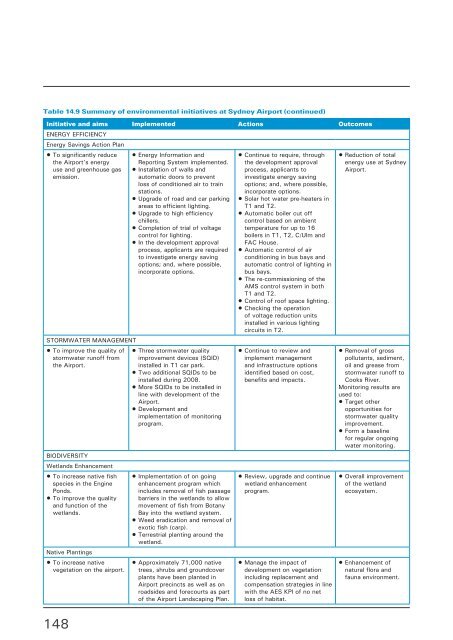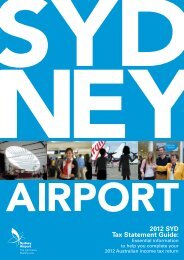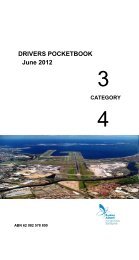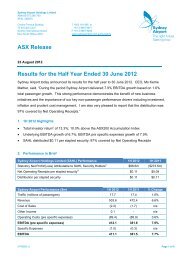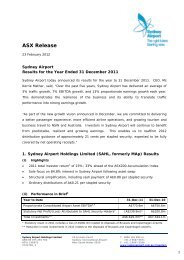Master Plan 2009 - Sydney Airport
Master Plan 2009 - Sydney Airport
Master Plan 2009 - Sydney Airport
Create successful ePaper yourself
Turn your PDF publications into a flip-book with our unique Google optimized e-Paper software.
Table 14.9 Summary of environmental initiatives at <strong>Sydney</strong> <strong>Airport</strong> (continued)<br />
Initiative and aims Implemented Actions Outcomes<br />
ENERGY EFFICIENCY<br />
Energy Savings Action <strong>Plan</strong><br />
• To significantly reduce<br />
the <strong>Airport</strong>’s energy<br />
use and greenhouse gas<br />
emission.<br />
STORMWATER MANAGEMENT<br />
• To improve the quality of<br />
stormwater runoff from<br />
the <strong>Airport</strong>.<br />
BIODIVERSITY<br />
Wetlands Enhancement<br />
• To increase native fish<br />
species in the Engine<br />
Ponds.<br />
• To improve the quality<br />
and function of the<br />
wetlands.<br />
Native <strong>Plan</strong>tings<br />
• To increase native<br />
vegetation on the airport.<br />
148<br />
• Energy Information and<br />
Reporting System implemented.<br />
• Installation of walls and<br />
automatic doors to prevent<br />
loss of conditioned air to train<br />
stations.<br />
• Upgrade of road and car parking<br />
areas to efficient lighting.<br />
• Upgrade to high efficiency<br />
chillers.<br />
• Completion of trial of voltage<br />
control for lighting.<br />
• In the development approval<br />
process, applicants are required<br />
to investigate energy saving<br />
options; and, where possible,<br />
incorporate options.<br />
• Three stormwater quality<br />
improvement devices (SQID)<br />
installed in T1 car park.<br />
• Two additional SQIDs to be<br />
installed during 2008.<br />
• More SQIDs to be installed in<br />
line with development of the<br />
<strong>Airport</strong>.<br />
• Development and<br />
implementation of monitoring<br />
program.<br />
• Implementation of on going<br />
enhancement program which<br />
includes removal of fish passage<br />
barriers in the wetlands to allow<br />
movement of fish from Botany<br />
Bay into the wetland system.<br />
• Weed eradication and removal of<br />
exotic fish (carp).<br />
• Terrestrial planting around the<br />
wetland.<br />
• Approximately 71,000 native<br />
trees, shrubs and groundcover<br />
plants have been planted in<br />
<strong>Airport</strong> precincts as well as on<br />
roadsides and forecourts as part<br />
of the <strong>Airport</strong> Landscaping <strong>Plan</strong>.<br />
• Continue to require, through<br />
the development approval<br />
process, applicants to<br />
investigate energy saving<br />
options; and, where possible,<br />
incorporate options.<br />
• Solar hot water pre-heaters in<br />
T1 and T2.<br />
• Automatic boiler cut off<br />
control based on ambient<br />
temperature for up to 16<br />
boilers in T1, T2, C/Ulm and<br />
FAC House.<br />
• Automatic control of air<br />
conditioning in bus bays and<br />
automatic control of lighting in<br />
bus bays.<br />
• The re-commissioning of the<br />
AMS control system in both<br />
T1 and T2.<br />
• Control of roof space lighting.<br />
• Checking the operation<br />
of voltage reduction units<br />
installed in various lighting<br />
circuits in T2.<br />
• Continue to review and<br />
implement management<br />
and infrastructure options<br />
identified based on cost,<br />
benefits and impacts.<br />
• Review, upgrade and continue<br />
wetland enhancement<br />
program.<br />
• Manage the impact of<br />
development on vegetation<br />
including replacement and<br />
compensation strategies in line<br />
with the AES KPI of no net<br />
loss of habitat.<br />
• Reduction of total<br />
energy use at <strong>Sydney</strong><br />
<strong>Airport</strong>.<br />
• Removal of gross<br />
pollutants, sediment,<br />
oil and grease from<br />
stormwater runoff to<br />
Cooks River.<br />
Monitoring results are<br />
used to:<br />
• Target other<br />
opportunities for<br />
stormwater quality<br />
improvement.<br />
• Form a baseline<br />
for regular ongoing<br />
water monitoring.<br />
• Overall improvement<br />
of the wetland<br />
ecosystem.<br />
• Enhancement of<br />
natural flora and<br />
fauna environment.


